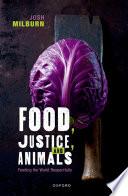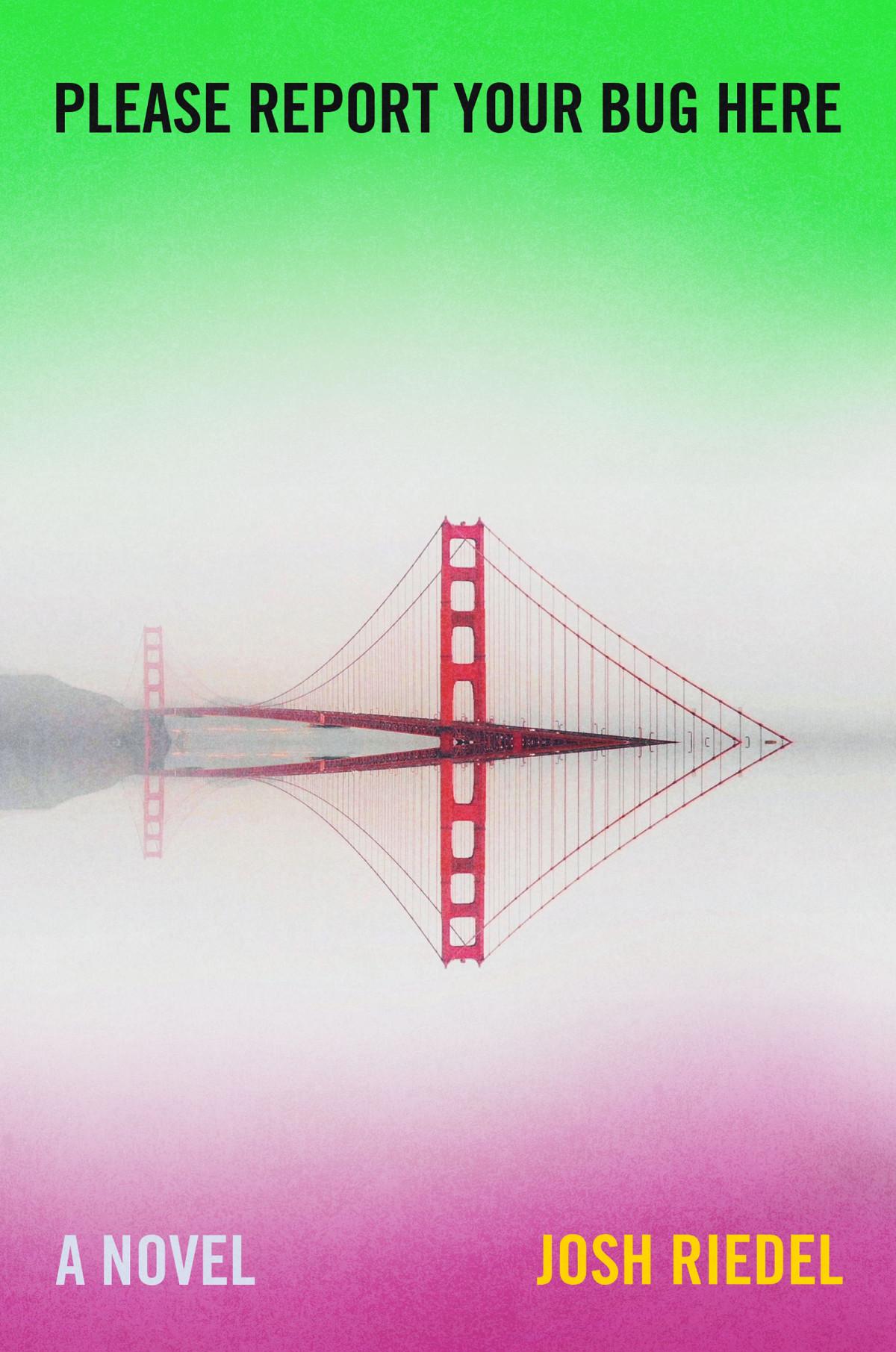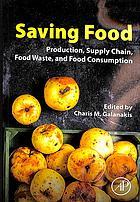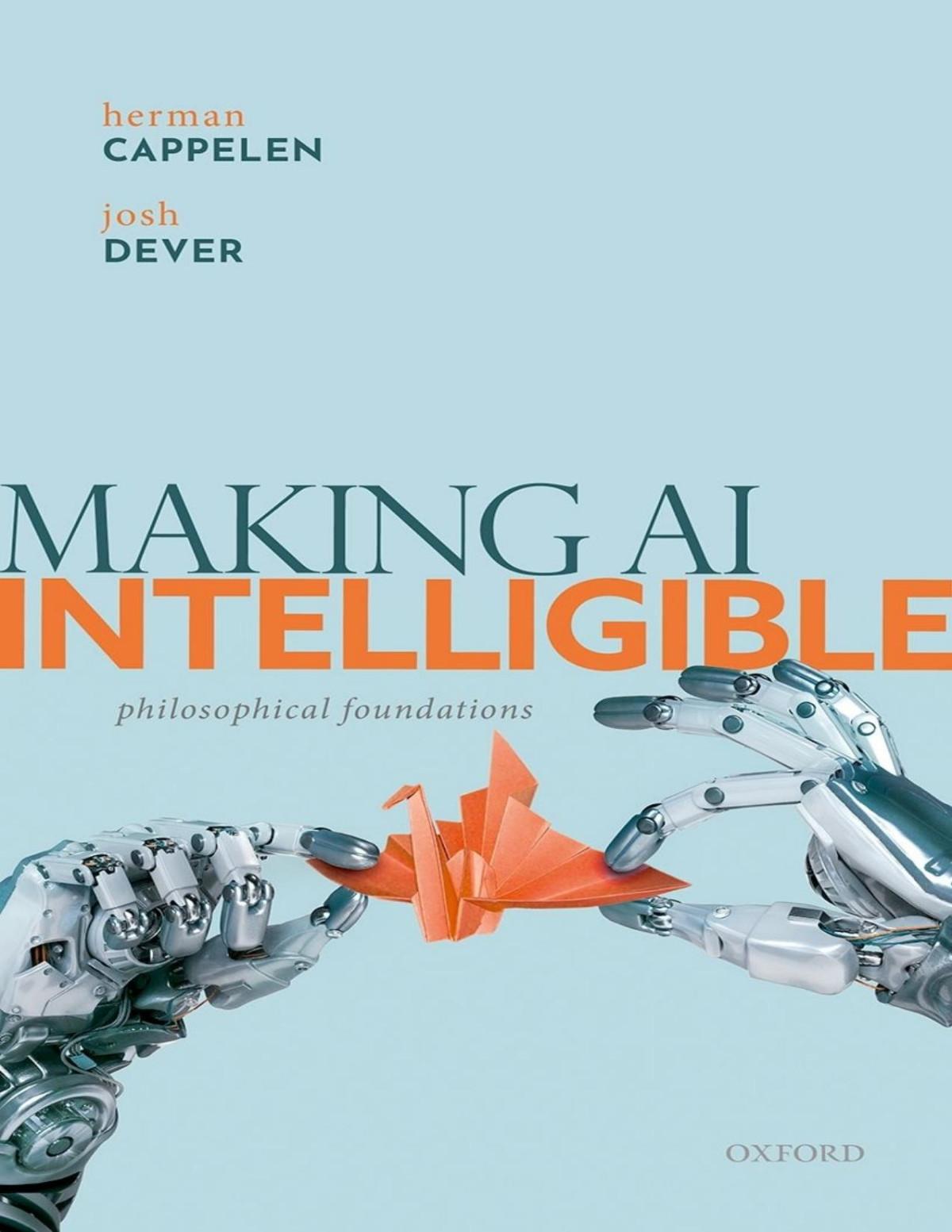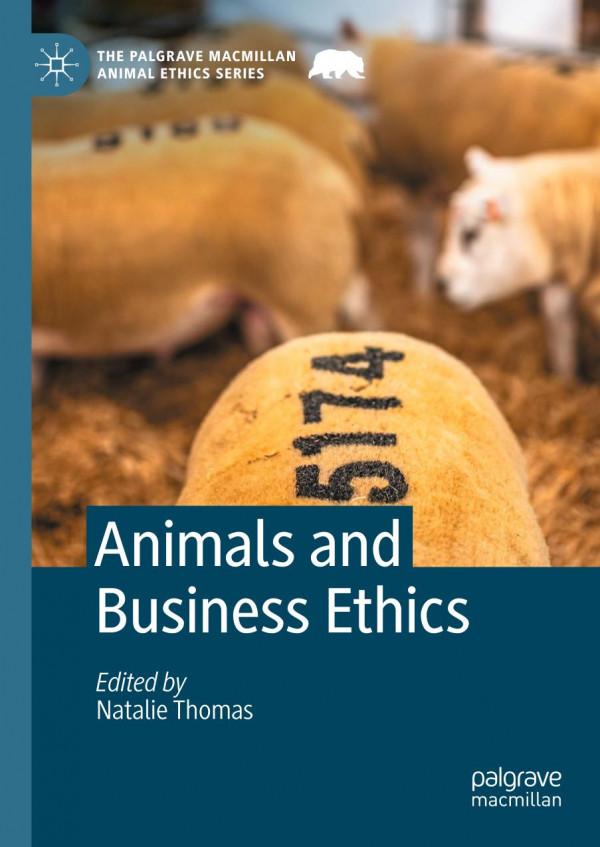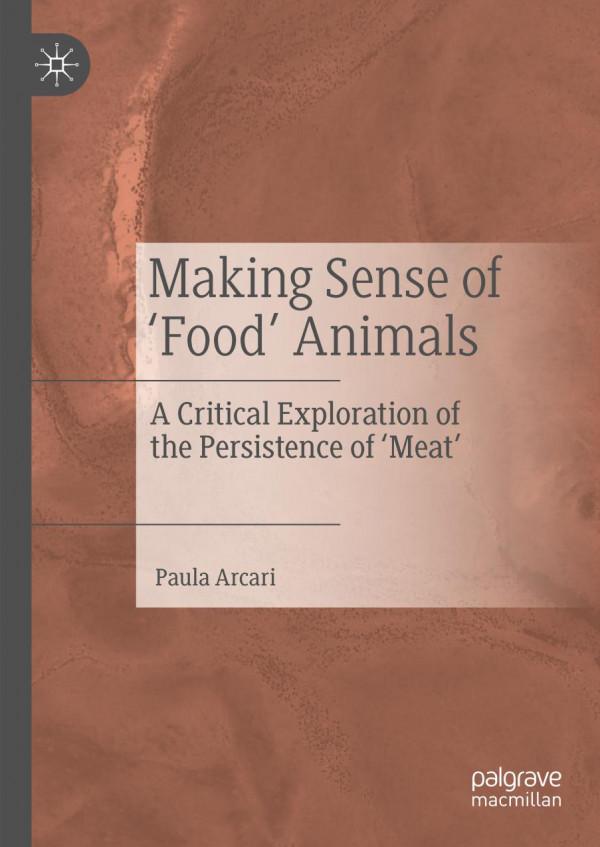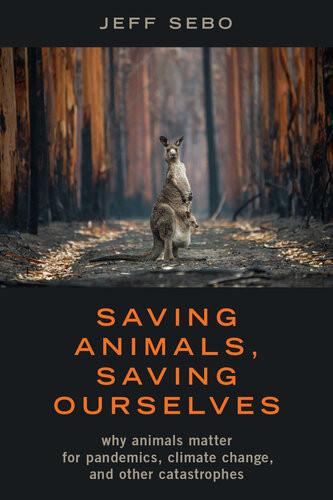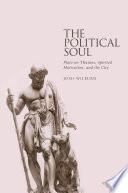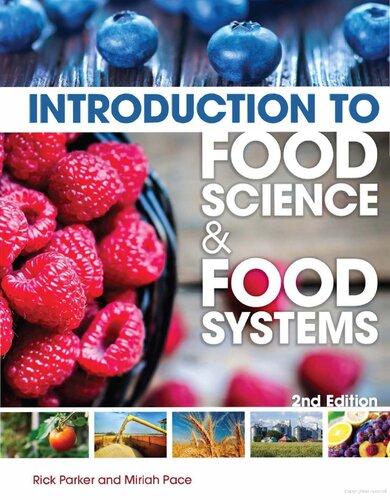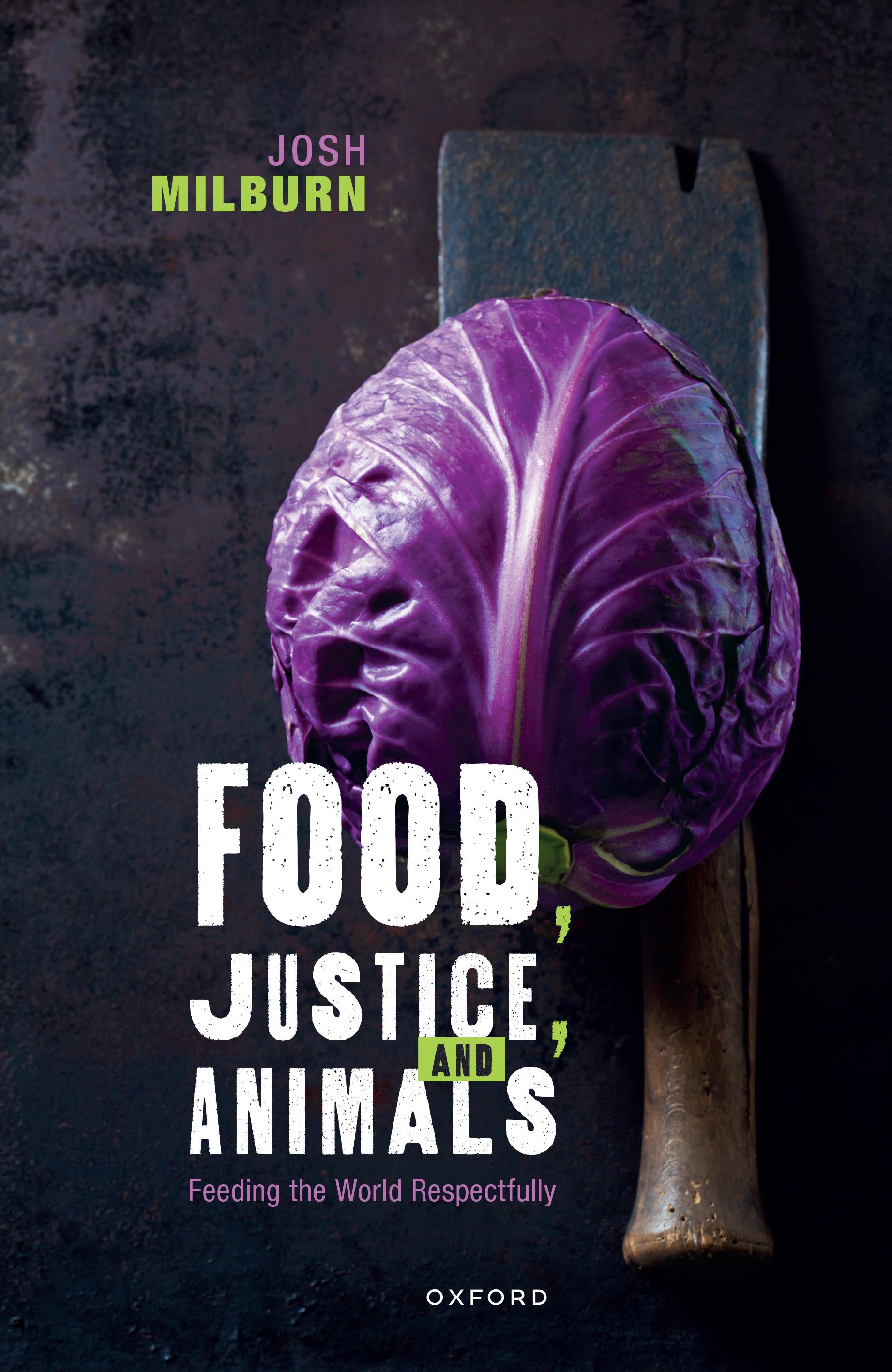Food, Justice, and Animals Josh Milburn Visit to download the full and correct content document: https://ebookmass.com/product/food-justice-and-animals-josh-milburn/
More products digital (pdf, epub, mobi) instant download maybe you interests ...
44.1644° North Josh Lanyon https://ebookmass.com/product/44-1644-north-josh-lanyon/
Please Report Your Bug Here Josh Riedel https://ebookmass.com/product/please-report-your-bug-here-joshriedel/
Saving Food : Production, Supply Chain, Food Waste, and Food Consumption Galanakis
https://ebookmass.com/product/saving-food-production-supplychain-food-waste-and-food-consumption-galanakis/
Making AI Intelligible Herman Cappelen & Josh Dever [Cappelen
https://ebookmass.com/product/making-ai-intelligible-hermancappelen-josh-dever-cappelen/
Animals and Business Ethics Natalie Thomas
https://ebookmass.com/product/animals-and-business-ethicsnatalie-thomas/
Making Sense of ‘Food’ Animals: A Critical Exploration of the Persistence of ‘Meat’ 1st ed. 2020 Edition Paula Arcari
https://ebookmass.com/product/making-sense-of-food-animals-acritical-exploration-of-the-persistence-of-meat-1sted-2020-edition-paula-arcari/
Saving Animals, Saving Ourselves: Why Animals Matter for Pandemics, Climate Change, and Other Catastrophes
Jeff Sebo
https://ebookmass.com/product/saving-animals-saving-ourselveswhy-animals-matter-for-pandemics-climate-change-and-othercatastrophes-jeff-sebo/
The Political Soul : Plato on Thumos, Spirited Motivation, and the City Josh Wilburn
https://ebookmass.com/product/the-political-soul-plato-on-thumosspirited-motivation-and-the-city-josh-wilburn/
Introduction to Food Science and Food Systems 2nd Edition Rick Parker
https://ebookmass.com/product/introduction-to-food-science-andfood-systems-2nd-edition-rick-parker/
Food,Justice,andAnimals Food,Justice,and JoshMilburn
GreatClarendonStreet,Oxford,OX26DP, UnitedKingdom
OxfordUniversityPressisadepartmentoftheUniversityofOxford. ItfurtherstheUniversity’sobjectiveofexcellenceinresearch,scholarship, andeducationbypublishingworldwide.Oxfordisaregisteredtrademarkof OxfordUniversityPressintheUKandincertainothercountries ©JoshMilburn2023
Themoralrightsoftheauthorhavebeenasserted Allrightsreserved.Nopartofthispublicationmaybereproduced,storedin aretrievalsystem,ortransmitted,inanyformorbyanymeans,withoutthe priorpermissioninwritingofOxfordUniversityPress,orasexpresslypermitted bylaw,bylicenceorundertermsagreedwiththeappropriatereprographics rightsorganization.Enquiriesconcerningreproductionoutsidethescopeofthe aboveshouldbesenttotheRightsDepartment,OxfordUniversityPress,atthe addressabove
Youmustnotcirculatethisworkinanyotherform andyoumustimposethissameconditiononanyacquirer
PublishedintheUnitedStatesofAmericabyOxfordUniversityPress 198MadisonAvenue,NewYork,NY10016,UnitedStatesofAmerica
BritishLibraryCataloguinginPublicationData
Dataavailable
LibraryofCongressControlNumber:2023900813
ISBN978–0–19–286746–9
DOI:10.1093/oso/9780192867469.001.0001
Printedandboundby CPIGroup(UK)Ltd,Croydon,CR04YY
LinkstothirdpartywebsitesareprovidedbyOxfordingoodfaithand forinformationonly.Oxforddisclaimsanyresponsibilityforthematerials containedinanythirdpartywebsitereferencedinthiswork.
Acknowledgements Iwrotethisbookfrom2019to2022,whileIwasaBritishAcademyPostdoctoralFellow.IthanktheBritishAcademyandmyhostinstitutions:the UniversityofSheffieldandLoughboroughUniversity.
ParticularthanksareowedtoAlasdairCochrane,whosesupportthroughouttheplanningandwritingofthisbookwasinvaluable.Idevisedand refinedtheprojectinconversationwithAlasdair,andheofferedcomments ondraftsofeverychapter.
ReviewersatOxfordUniversityPressalsoofferedextensive,valuablecommentsonthisproject.OneofthesereviewerswasJeffSebo,whokindly continuedtooffercommentsafterthecompletionofthereviewprocess,and helpedshapethebook.
Ipresentedanddiscussedideasfromthebookinmultipleoutlets,includingarangeofpresentationsattheUniversityofSheffield;invitedlecturesat AberystwythUniversityandtheUniversityofWinchester;multiplepresentationsattheMANCEPTWorkshopsinManchester;andpresentationsat theconferencesoftheAustralasianAnimalStudiesAssociation,theEuropeanAssociationforCriticalAnimalStudies,andTheVeganSociety.Ithank audiencesfor—oftencritical!—commentsanddiscussionontheseoccasions.
Ideasinthebook,however,stretchbackadecadetowhenIfirstseriously startedthinkingaboutfoodandfoodsystemsinmypostgraduatestudies.It isthusimpossibletonameeverybodytowhomIowethanksinadditionto thoseabove,butamongthemareDavidArchardandJeremyWatkins,my doctoralsupervisorsatQueen’sUniversityBelfast;SueDonaldsonandWill Kymlicka,withwhomIworkedonapreviouspostdoctoralprojectatthe unrelatedQueen’sUniversityinKingston,Ontario;BobFischer,withwhom Ihaveco-writtenmultiplepapersontheethicsofeatinganimalproducts; andMatteoBonotti,whofirstencouragedmetothinkaboutfoodpolicyand offeredhelpfuladviceonthisproject.
ImustalsoacknowledgetheongoingsupportofmyfiancéeBecca,who championsmyworkifnotalwaysmyconclusions,andofmydogsHollieand Casper,whomadetheyearsoftheCOVID-19pandemic,whileIwrotethis book,abitbrighter.
Acknowledgements
IdedicatethisbooktoSiobhanO’Sullivan,whowasdiagnosedwithovariancancerin2020.Siobhanisachampionofanimals,andabelieverinthe powerofacademicworktomaketheworldbetterforthem.Her Animals, Equality,andDemocracy(2011)wasapathbreakingextensionofliberalpoliticalthoughttoanimalprotection,andIamproudtothinkof Food,Justice, andAnimals asfirmlyinthesametradition.
Introduction Imaginetheburgerbarofabettertomorrow—of2030,or2050,or2100,or 2500.What’sonthemenu?Maybewecanimaginewidespreadchangesto makeamoreaccessiblefoodsystem.Themenucouldfeaturetheburgers,fries, andicecreamoftoday,butwithmuchlowerpricetags.Orwemightimaginewidespreadchangestomakea healthier foodsystem.Maybetheburgers arereplacedwithleanchicken,thefrieswithsalad,theicecreamwithfruit. Orwemightimaginewidespreadchangestomakeamore environmentally sustainable foodsystem.Maybebeefisoffthemenu,butsustainablyfarmed fishremains.
Butwecouldalsoimaginewidespreadchangestomakeamore animalfriendly foodsystem,orevenonethatrespectsanimals’ rights. Whatwould beonthemenuthen?
Tosupportourcurrenteatinghabits,tensofbillionsofvertebratesare slaughteredannually.Manyhavelivedlivesofsufferingathumanhands.Trillionsoffish—wildandfarmed—arekilledannually.AndIcouldinflatethese numbersenormouslybyincluding other animals1 killedfor,orinpursuit of,food—invertebratesofallkinds,malechickskilledintheeggindustry, animalshuntedandtrappedforfood,andsoon.Itisthefoodsystemthat facessomeofthelargestchangesifwe(asasociety)aregoingtotakeanimals seriously.
Supposeanimalshaverights.Thismeansthattherearecertainthingsthat cannotbedonetothemwithoutinjustice.We,collectively,shouldprotect thoserights,ideallythroughthepowerofthestate.Thisisnotabookabout whatrightsanimalshave,orthereasonsthattheyhaverights.Thereare alreadylotsofbooksaboutthosethings.Instead,thisbookstartswithanimals’rights,andaskswhatastatethatrespectsthemlookslike.Itfocuseson thefoodsystemofthisstate,asitis(arguably)thecontemporaryfoodsystem thatisresponsibleforthemostegregiousviolationsofanimals’rights.Ifthe stateisconcernedwithprotectinganimals’rights,thatraisesgraveconcerns aboutourfoodsystem.Indeed,itraisesgraveconcernsaboutfoodsystems
1 Intheinterestsofreadability,Ifollowtheconventionalpracticeofusingtheword animals toreferto animalsotherthanhumans.Thisisimprecise,ashumansarealsoanimals.
Food,Justice,andAnimals.JoshMilburn,OxfordUniversityPress.©JoshMilburn(2023). DOI:10.1093/oso/9780192867469.003.0001
altogether.Isthereaviablealternativefoodsystemthatrespectsanimals’ rights?
Itmightseemthattheresponseisobvious.Ifjusticeentitlesanimalsto legallyprotectedrights,thenourfoodsystemswillhavetobeplant-based. Animalsmaynotbekeptsothattheycanbekilledandtheirbodiesbeturned intomeat,orsothattheycanbekeptalive(foratime)fortheirbodiesto producemilk,eggs,honey,orotherproductsthatendupinfood.
ButIamnotsurethisanswerisright.Infact,itistheclaimofthisbookthat ourfoodsystemsdonotneedtobefullyplant-based,eventhoughanimalsare entitledtolegallyprotectedrights.Wecertainlycannotkillortortureanimals forfood,buttheycanstillbeinvolvedinourfoodsystems,andwecanstill eatanimalproducts.
Consequently,Iproposethattheanimal-rights-respectingstatecould containaveritablecornucopiaofanimalproducts:themeatofallkinds ofvertebrateandinvertebrateanimals;birds’eggs;mammals’milk;anda rangeoffoodstuffsproducedusinginvertebrates,suchashoney,shellac,and cochineal.Whatismore,theruralspacesofthishypotheticalstatecouldstill havefieldsofcows,sheep,chickens,goats,andotherdomesticatedanimals. Notonlycouldtherebeanimalproteinforthehungryandthosewhovalue it,buttherecouldbeworkwithanimalsforthosewhowantit.Notthebrutal workoftheslaughterhouseorfactoryfarm,but good work—humane work. Perhapsinthisstate,wewillhaveourcow,but,ifwewantto,wewilleat her,too.
Myvisionofananimal-rights-respectingstateisavisionofastatein whichwedonotkillanimalsormakethemsufferforhumanpurposes, fromthetrivialtothequiteconsequential.Borrowinganevocativeterm fromSueDonaldsonandWillKymlicka(2011)—withoutcommittingtothe detailsoftheirposition—Icallthisthe zoopolis.Thezoopolisisastatein whichanimalsarerespectedasindividuals,entitledtoliveasapartofour community—and,indeed,entitledtoaffectthedirectionofourcommunity, throughinvolvementwithpoliticalprocesses.Nonetheless,andtorepeat,I believethezoopolisisastateinwhichanimalproductscould—should—be available.How?Gettingtothebottomofthisquestionisthepointofthis book.
Inthechaptersthatfollow,Iexplorearangeofpossibleroutestoanimalproteinthatare,mightbe,orcouldbeconsistentwithfullrespectfor animals’rights,andarethusthekindsofelementsthatmaybepartofan all-things-consideredbestfoodsystemforthezoopolis.Inbrief,Iarguethat someanimalsarenon-sentient(orarealmostcertainlynotsentient)andthus weowethemnothingdirectly—wemayutilizethemfreely.Oystersmightbe
anexample.Others probably arenotsentient,sowecanutilizethemwith caution.Insectsmaybelonginthiscategory.
Otheranimalsaresentient,orprobablyso,andsoweowethemconsiderablerespect—namely,rights.However,wecould,consistentwiththisrespect, welcomethemintoourcommunitiesandworkplaces,andwork with them toproducethingsofbenefittoall.Theconfinement,objectification,mutilation,andslaughterofcontemporaryanimalagriculture—even‘high-welfare’, ‘local’,‘organic’animalagriculture—isinimicaltorespectinganimals’rights. Butworkingwithanimalstoproduceeggs,milk,wool,andmoreneednotbe. (Particularlyimportant,forreasonsIwillmakeclear,isworkingwithanimals for cells.)
Whataboutmeat?‘Plant-basedmeat’promisesburgers,nuggets,and evensteaksculinarilyindistinguishablefrom‘traditional’,orslaughter-based, meat.Meanwhile,‘cellularagriculture’promises‘cultivated’meat—whichis, inprinciple, physically indistinguishablefromslaughter-basedmeat—with onlytheslightestanimalinput.Crucially,wewillsee,thepracticeof meat-eatingisnot itself rights-violating—evenif(almost)allthewaysthat wecurrentlyacquiremeat are rights-violating.Andbothplant-based‘animal’productsandcellularagriculturestretchbeyondmeat.Icontendthat plant-basedorcultivatedmilk,eggs,honey,andmoremaybeavailableinthe zoopolis.
Iexploredetailsoftheseaspectsofhypotheticalfoodsystemsoverthe remainderofthebook,andIofferamoredetailedchapter-by-chapterbreakdownattheendofthisintroduction.Fornow,however,itisimportantto brieflysituatethepresentstudy.
Animals,rights,andpolitics Wecanroughlysplitanimalrightsscholarshipinhalf.Coretothe‘old’animal rights(Regan1983;Francione2000)isagroundinginmoralphilosophyand, crucially,afocusonveganism.Contrastingitselfto‘welfarism’—mainstream inbothanimalactivism(see Francione1996)andethicalstudyofhuman–animalrelationships(see Singer1975)—oldanimalrightsdidnotsupport simplymakinganimalagriculturemorehumane.Itsupported abolishing animalagriculture,andhumanuseofanimals,alltogether.AsTomRegan putit,
Whenitcomestohowhumansexploitanimals,recognitionoftheirrightsrequires abolition,notreform.Beingkindtoanimalsisnotenough.Avoidingcrueltyisnot
enough.Whetherweexploitanimalstoeat,towear,toentertainus,ortolearn,the truthofanimalrightsrequiresemptycages,notlargercages.
(Regan2004a,10)
Inoldanimalrights,veganismisa‘moralbaseline’—thebareminimumwe oweanimals(Francione2012).
Whatisveganism?Forthepurposesofthisbook,Iaminterestedin veganismasitrelatestofood.Itreat‘vegan’and‘plant-based’asroughsynonyms,adoptingapractice-baseddefinition,accordingtowhichveganismis aboutabstentionfromanimalproducts,ratherthanpoliticalcommitments (DicksteinandDutkiewicz2021).Avegandietorfoodsystemisonewithout animalproducts.Avegandietorfoodsystemmaybeconsistentwithanimal rights.Itmaybethe only foodsystemordietconsistentwithanimalrights. ButIcontendthatthesearequestionsworthexploring;theyarenottrue by definition.
Advocatesofoldanimalrightsmadeacaseforveganismin moral,rather than political,terms.Wecancertainlyexaggeratetheextenttowhichthe advocatesofthisoldapproachwereapolitical(Cochrane,Garner,and O’Sullivan2018),buttheyweregenerallyexpressingthemselvesas—andread by—moralphilosophers.Ifadvocatesofthisoldapproachdidofferapolitical philosophy(see,e.g.,Schmitz2016),theywoulddefendplant-basedstates,far removedfromthoseenvisionedinthisbook.
Butthereisalsoa‘new’animalrights,groundedin political philosophy,ratherthanmoralphilosophy.Therehasbeen,inthewordsofmany commentators,a‘politicalturn’inanimalethics(AhlhausandNiesen 2015; Milligan2015; DonaldsonandKymlicka2017; Cochrane,Garner, andO’Sullivan2018).Thisopensanimalethics—thenormativestudyof human–animalrelationships,thestudyofhowwe ought tointeractwith animals—tonewvocabulariesandconcepts.Butitalsoopensnewquestions.Forexample,animalethicistshavemovedfromaskingindividualistic questionsaboutanimals(‘ShouldIbevegan?’‘Howdoesavirtuousperson treattheirdog?’‘Whatisthevalueofananimalrelativetoahuman?’)toask moresocietal,socio-politicalquestions(‘Whatlawsshouldprotectanimals?’ ‘Whatformsofdemocracyaregoodforanimals?’‘Cananimalsbeourcocitizens?’).
Theoristsofthis‘new’approachtoanimalrightsdointerrogatefood(e.g. DonaldsonandKymlicka2011,134–139; Cochrane2012,chapter 4; Wayne 2013),settingupinoppositiontothe‘abolitionism’ofoldanimalrights.Veganismceasestobeamoralbaseline,andrespectforanimalrightsceases
tomeantheendofhuman–animalinteractions.Consequently,theoristsof newanimalrightsareexplicitlyopentonon-vegandietsandstates,buttheir commentsstopshortofworked-outfoodsystems.Perhapstheenvisioned productiononlyworksonasmallscale—individualsorsmallcommunities— andthusfallshortofbeingacontenderforafood system.Alternatively,or additionally,commentsonfoodproductionmaybebrief,inconclusive,or scattered.
Take,forinstance,DonaldsonandKymlicka.Wecanputasidethedetails oftheirframeworkfornow—letussimplyaskwhattheysayaboutthefood systemofthezoopolis.Theansweris:surprisinglylittle.Likealladvocatesof animalrights,oldornew,theyseecontemporaryfoodsystemsasbeyondthe pale.Recognizinganimals’rights,theysay,meansrecognizingthatanimals werenotputontheearthtofeedus,whiletherightsthemselvesrule‘out virtuallyallexistingpracticesoftheanimal-useindustries’(Donaldsonand Kymlicka2011,40).Theyconsequentlyspeakinglowingtermsofa‘switch toveganism…onasocietalscale’(2011,202).
ThisrejectionofanimalfoodsleadsRobertGarner,anotheradvocateof newanimalrights,tolamentamissedopportunityfornoveltyinDonaldsonandKymlicka’swork.Forhim,their‘startingpointistheacceptance, asabaseline,ofatraditionalspecies-egalitarianabolitionistanimalrights agenda’(Garner2013,103)—theoldapproachtoanimalrightsagainstwhich DonaldsonandKymlickapositionthemselves.GarnerseesDonaldsonand Kymlickaasofferingapoliticizedvisionoftheoldanimalrights.Their framework,hesays,
hastheeffectofrulingoutofaccountthedomesticationofanimalsforexploitativehumanpurposes.Animalagriculture[is]thereforemorallyillegitimateonthe groundsthattouseanimalsinsuchawayistoinfringetheirrights.…[Donaldson andKymlicka]adoptananimalrightsethicthatrulesouttheuseofanimalsfor food[.]
(Garner2013,104)
ButGarnerisonlyhalfright.ForDonaldsonandKymlicka,co-livingwith animals can beconsistentwithsharingmilkwithcows,oreatingeggslaidby chickens,orgatheringwool(forfoodadditives)fromsheep(2011,136–139). Andtheyaskquestionsaboutboththecorpsesofanimalswhohave diednaturallyoraccidentally,andaboutcellularagriculture—twopotentiallyrights-respectingsourcesofmeat(2011,151–152).Theydonotraise someotherquestions.Forexample,theydonotaddress(sodonotruleout)
humanseatingnon-sentientanimals,2 andtheydonotaddresscellularagriculturebeyondcultivatedmeat.
Thereare,however,atleastthreereasonstoquestionDonaldsonandKymlicka’sscatteredcommentsonusinganimalsforfood.And,torepeat,my explorationofDonaldsonandKymlicka’scommentsisindicative.Icould levelsimilarcriticismatotherscholarsofnewanimalrights.
First,DonaldsonandKymlickahedgetheirarguments,reachingnofirm conclusionsaboutanimalproducts.Whiletheydonotruleanimalproducts out,neitherdotheyreallyendorsethem.
Second,DonaldsonandKymlickadonotexplorethereasonsthatwemight haveforendorsingnon-veganfoodsystems,evenasadvocatesofanimal rights.Tobeclear,therearesuchreasons. Garner(2013) offersarguments aboutthe practical benefitsforanimalsandtheanimal-rightsmovement; hisreasonsarepragmatic.Myownreasons,exploredinChapter 1,are principled.
Third,andperhapsmostsurprisingly,DonaldsonandKymlicka’sdiscussionsofanimalproductsarenoticeablysmall-scale.Theirdiscussionsevoke imagesof,forexample,familieskeepingchickensinbackyardsandcollecting(thoughnotselling)eggs,orindividualscollectingthecorpsesofanimals killedontheroadtofeedcompanioncats.Thereseemstobelittlebywayof afood system emergingfromtheseideas.
Thus,onhowcitizensofthezoopoliseat,DonaldsonandKymlickaare caughtbetweenthestraightforward—abolitionist—visionoftheveganstate, and somethingelse.Thissomethingelseisafoodsystemfarfromthosein twenty-firstcenturystates(oranyhistoricalstate),butitisunspecified,or,at least,underspecified.Itisthegoalofthisbooktospecifythat‘somethingelse’, andofferavisionofanon-veganfoodsystemthatmightsustainthezoopolis.PerhapsthatzoopolisresemblesDonaldsonandKymlicka’svision,but perhapsitresemblesoneofthe(moreorless)competingorcomplementary visionsofferedbyother(moreorless)liberalthinkersworkinginthe‘political turn’.Irefertomanyofthesethinkers’ideasoverthecomingchapters.
Thisbookoffersclearstepstowardsafoodsystemforanimalrights theory—butafoodsystemfor new animalrights,andalong-neededalternativetothefoodsystemoftheabolitionists.But,morethanthis,itoffersafood systemthatpeoplecommittedtoawiderangeofcompetingvalues—animal advocatesandanimalagriculturalists;vegansandfoodies;environmentalists andfood-justiceadvocates—couldchampion.
2 DonaldsonandKymlickaaresentientists(seeChapter 2),sotheywillnotconceivenon-sentient animalsasrightsbearers.Tomyknowledge,however,theyneveraddressthisissueexplicitly.
Animalsandjustice Fortheoristsofanimalrights,oldornew,thestandardpracticesofwesternanimalagricultureareunjust.Withfewexceptions,itisunjustto slaughteranimals;confinethemtocrampedsheds;mutilatethem.Thus,for animal-rightstheorists(incontrasttosomeotheranimalethicists)justicehas alwaysbeenimportant.However,forthetheoristsofnewanimalrights,itis central—adefiningconcern.Asthreescholarscentraltothepoliticalturn putit,
thecrucialunifyinganddistinctivefeatureofthesecontributions[toanimalethics inpoliticalphilosophy]—andwhatcanproperlybesaidtomarkthemoutasa ‘politicalturn’—isthewayinwhichtheyimaginehowpoliticalinstitutions,structuresandprocessesmightbe transformed soastosecurejusticeforbothhuman andnon-humananimals.Putsimply,theessentialfeatureofthepoliticalturnis this constructive focusonjustice.
(Cochrane,Garner,andO’Sullivan2018,263–264)
Itshouldbeclearthatthecurrentprojectaimstoimaginehowpolitical institutions,structures,andprocesses—specifically,foodsystems—mightbe transformed.Butwhat,precisely,is justice?
JusticehasbeencentraltopoliticalphilosophysinceatleastPlato’s Republic,whichisessentiallyanenquiryintothemeaningofjustice.For Plato,justiceisultimatelyabouteverything(includingpeople)beinginits (their)properplace,andthusabouteverything(includingsocietyasawhole) beingbalanced.Incontemporarypoliticalphilosophy,afocusonjusticeis owedinparttoJohnRawls.Hedistinguishesbetweenthe concept ofjusticeandvaried conceptions ofjustice.Iwillreturntospecificconceptions shortly,butwhattheyshare—andthuswhatgetstothebottomofthe concept ofjustice—isthattheyoffer:
principlesforassigningbasicrightsanddutiesandfordeterminingwhattheytake tobetheproperdistributionofthebenefitsandburdensofsocialcooperation.
…Thosewhoholddifferentconceptionsofjusticecan,then,stillagreethatinstitutionsarejustwhennoarbitrarydistinctionsaremadebetweenpersonsinthe assigningofbasicrightsanddutiesandwhentherulesdetermineaproperbalancebetweencompetingclaimstotheadvantagesofsociallife.Mencanagree tothisdescriptionofjustinstitutionssincethenotionsofanarbitrarydistinction andofaproperbalance,whichareincludedintheconceptofjustice,areleftopen foreachtointerpretaccordingtotheprinciplesofjusticethatheaccepts.These
principlessingleoutwhichsimilaritiesanddifferencesamongpersonsarerelevant indeterminingrightsanddutiesandtheyspecifywhichdivisionofadvantagesis appropriate.
(Rawls1999,5)
WhenRawlssays persons,heisimagininghumans—orperhaps some humans.But(becauseanimalscanbepersons,becausejusticecanstretch beyondpersons,orboth)weneednotlimitjusticetohumans.Thepointof thepoliticalturninanimalethicsisthatdiscussionsofjusticeinthetwentiethcenturyignoredanimals—theoristsrelegatedquestionsaboutanimals to‘mere’morality.Atbest,questionsaboutanimalswerea later or derivative questionforjustice,ratherthansomethingtheoristsmustprincipallyaddress (see Nussbaum2007,chapter 1).
Justiceforanimalsshouldnotariseonly‘after’wehaveresolvedquestions aboutjusticeforhumans—intheory or practice.Justiceisimportantforanimalsbecausethedemandsofjusticeareparticularlystringent.Theyarenot merelythingsitwouldbe nice or good or charitable or virtuous todo.They arenoteventhingsthatweshouldinsistupon—atleast,weshouldnotstop at insistence.Instead,thedemandsofjusticearesostringentthatpeoplemight legitimately coerce othersintomeetingthem.
Forexample,itmightbenice,good,charitable,orvirtuousofmetodonate muchofmyincometoaworthycharity.Ifmymoralconvictionsleadmeto endorsetheeffectivealtruismmovement,orIslam’s zakah principle,3 Imight eventhinkIam morallyrequired todonate.ButitisunlikelythatIthinkthat Iam requiredbyjustice todonatelargeamounts.Indeed,thissoundsparadoxical;ifIamrequiredbyjusticetodonate,itdoesnotsoundlike donation atall.Donationsare,bydefinition,supererogatory(thatis,theygobeyond myduty).IfIfailto‘donate’whenrequiredbyjusticetodoso,thenothers (likelyactingonbehalfofthestate)may(orshould) force metodonate,and perhapspunishme.
Infocusingonjustice,politicalphilosophyisahigh-stakesbranchofethics: ‘It’snotjustaboutwhatpeopleoughttodo,it’saboutwhatpeoplearemorally permitted,andsometimesmorallyrequired, tomakeeachotherdo’(Swift 2013,24,emphasisadded).
Ifourdutiestowardsanimalsaremattersofmeremorality,then,nomatterhowimportanttheyarewithinourmoraltheory,wehavenobusiness forcingeachothertoobeythem.Inaliberalsociety,disagreementsabout
3 IthankananonymousUniversityofSheffieldstudentforthisexample.
moralityaretobetolerated.IfIthinkalcoholisimmoral,butyouthinkteetotalismisprudishself-abnegation,thensobeit.Wemustacceptthatthe otheris(perceivedtobe)wrong.Youhavenobusinessforcingmetotryfine wines,andIhavenobusinessstoppingyoufromenjoyingthem.Toborrow thewordsofJohnStuartMill,althoughnotingtheywereoriginallypresented inaslightlydifferentcontext,myfeelingthatsomeoneisnotbehavingin accordancewiththe(frommypointofview,andforallanyoneelseknows, true)normsofvirtuousconsumptionmightpresent‘goodreasonsforremonstratingwithhim,orreasoningwithhim,orpersuadinghim,orentreating him,butnotforcompellinghim,orvisitinghimwithanyevilincasehedo otherwise’(Mill2008,14).
Itshouldthusbeclearwhyrelegatingharmstoanimalstothedomainof themerelymoralwillbeverybadforanimalsinaliberalstate(Garner2013, chapter 3).Imagineyouthinkitmorallyacceptable—evenmorallygood—to doawfulthingstoanimals.Imagine,forexample,thatyouareagourmetof themostmorallydubiouskind,andthinkthatitis good thatpeoplecatch ortolanbuntings,stabouttheireyes,forcefeedthem,thendrownthemin brandysothattheycanberoastedandeaten.Orconsiderotherostensibly cruelfoodstuffs,whichyoumightthinkit good toexperience:thefoiegras ofFrance,whichinvolvesfarmersforce-feedingbirdstoengorgetheirlivers;the ikizukuri ofJapan,whichinvolveschefscuttingandservinglivefish, octopuses,andothers;lobsters,whocooksdropliveintoboilingwater;orthe YinYangfish(‘dead-and-alivefish’)ofTaiwan,whichhasadeep-friedbody, attachedtoastill-livinghead.
Ormaybeyouthinkitisgoodthatchefssupportkillinganimalsparticularly rare,orparticularlyintelligent,orparticularlyhuman-like,toofferunrivalled diningexperiences:CentralAfricanbushmeatmadefromgorillasandchimpanzees;JapaneseorFaroesecuisinecontainingdolphinorwhalemeat;dogs bredfortheKoreandog-meattrade.
Imagine,too,thatyouareunmoved—toevokeMill—bymyremonstrating,reasoning,persuading,orentreating.Whatthen?Intheliberalstate,if ourdutiestoanimalsarenotmattersofjustice,Imustsimplytolerateyour egregiouslyharmfulbehaviour,justastheteetotallerandsommeliermust tolerateeachother.
Butsomeoneseemstohavebeenforgotten,here.Peoplewithdifferent visionsofthegoodlifetoleratingeachother’spursuitofhappinessisone thing.Indeed,itiscentraltothecurrentproject.Butwhenthatpursuitofhappinessinvolvessomeoneelse—theFrenchgoose,theKoreandog,theFaroese whale—questionsofjusticeenter.
Thisiswhereitisworthreintroducing conceptions ofjustice.Thisbook beginswiththecontentionthatanimalshaverights.Asaconceptionofjustice(or,moreprecisely,setofconceptions,orpartofaconception),animal rightstakesasarbitrarytheideathathumansaresomeones,aboutwhomjusticeclaimscanbemade,whileanimalsaresomethings,theuseofwhichmust betolerated.(Astoryaboutwhatconstitutesanarbitrarydistinctioninthe attributionofrightsandduties,recall,iskeytoRawls’sexplanationofconceptionsofjustice.)Andifanimalsaresomeones,entitledtoprotection,it isonlynaturalthatthisisputintothelanguageofrights.Likejustice,rights canbeunderstoodasthosemoralentitlementsforwhichonecan‘demandor enforcecompliance’(Nozick1981,499).Forpoliticalphilosophy,then,rights arecentral.Thisisbecausepoliticalphilosophy,initsfocusonjustice,isthe ‘theoryofwhatbehaviorlegitimatelymaybeenforced,andofthenatureof theinstitutionalstructurethatstayswithinandsupportstheseenforceable rights’(Nozick1981,503).
InthisNozickianlanguage,myquestioninthisbookiswhichwaysof acquiringfoodthestatemayprohibit,and,moreimportantly,whichthey may not,toensurethatthestatedoesnotoverstepitsmark.Forliberals,any restrictionoffreedomisregrettable.Wemustensurethatanimalrightsdonot become,inthewordsofonecritic,toolsthat‘onlyconferadditionalpoweron governmentsandbureaucratstorunourlivesforus’,ratherthangenuineprotectionsforanimals(Machan2004,23).Stateinterferencewithlibertymust gofarenoughtorealizejustice—forhumans and animals—butnofurther.If itgoesfurther,thestatewill,itself,beguiltyofunjustimpositions.Achieving justiceisadelicatebusiness.Toolittleinterference,andonesetofindividuals(here,animals)loseprotectionstowhichtheyareentitled.Toomuch, andanothersetofindividuals(here,humans)loselibertiestowhichtheyare entitled.
Butthereisapuzzlehere,whichImustacknowledge.Itisfinetosay wemusttoleratedisagreementsaboutmorality,whilewecanenforcethe demandsofjustice.Butthereisdisagreementaboutwhatconstitutesjustice. Forexample,manyliberalswilldisagreethatanimalshaverights.Well,so beit—again,thisisnotabookarguingthatanimalshaverights,itisabook exploringtheconsequencesofanimalrights.Ifmycriticsprefer:itisabook exploringwhatitwouldmean ifanimalshadrights.
Butthisdoesnotsolvetheproblem,asthereisstillroomfordisagreement betweenadvocatesofanimalrightsabout which rightsanimalshave—or whichofourdutiestoanimalscrossthelinefrom mere moralitytoissues ofjustice.Ihopetosidestepmanyofthesedisagreements,butIwillsaya littlemoreabouttherightsanimalshavelaterinthisintroduction.
AndyetthereismoredisagreementImustacknowledge.Thereis disagreement—evenbetweenliberals—abouttheareasoverwhichthestate hasobligations(orpermissions)tointervene.Putanotherway,thereisdisagreementoverhowmuchinterferenceandcontroloverourlivesliberalstates permissiblyexercise.Again,Ihopetobeabletosidestepmanyoftheseconcernsbynottakingtoostrongastance.Iamliberal,butIamnotconcerned herewithspecifyingexactlywhat‘flavour’ofliberal.Nonetheless,Iwillreturn tothisissueinChapter 7.
Beforemovingon,letmebrieflyreturntoortolans,dolphins, ikizukuri, andtherest.Strikingly,whilenostaterecognizesanimalrightsasendorsed inthisproject,liberalstatestypically do banmanyof(orall)thepracticesI listedearlier.IfIlivedinEuropeorNorthAmericaandIknewthatmyneighbourwasslaughteringherdogforsomeKoreancooking,orchattingwith anortolancatcheraboutsourcingbuntings,orplanningtoopenaJapanese restaurantspecializingindolphins,whales,and ikizukuri,Icouldcontactthe authorities.And,dependingonthelawsofmystate(andtheprioritiesofthe authorities…),Imightbeabletousethecoercivepowerofthestatetostop (orpunish)myneighbour.Maybe,then,animalrightsasamatterofjustice arenot too alientocontemporaryliberalsocieties.
Foodjustice Itisworthmentioninganothersidetodiscussionsofjusticethat,regrettably, hasanambivalentrelationshipwithanimalrights: foodjustice.
Liketheliberalidealofmutualtolerationofpursuitofthegoodlife,thetraditionalconcernsoffoodjusticearecentraltothemotivationsofthisproject. Theseincludeaccesstogood,plentifulfoodforall;accesstoculturallyappropriateandimportantfoodsforthoseofminoritycommunities;availabilityof goodworkintheproductionoffoodandtheabolitionofexploitativelabour practices;theproductionoffoodinwaysrespectfultothelocalandglobal environment(andthepeoplewholiveintheseplaces);security,resilience, andindependenceinfoodproduction;andpopularandlocalcontroloffood productionanddistribution.Thesearerealissues,andreferencetothemwill appearthroughoutthebook.Butmyfocusinthissectionisnotontheissues themselves,butontherelationshipbetweenfoodjusticeandanimalrights.
Foodjusticeemergedasanoverlappingconcernofseveralactivist,scholarly,andscholar-activistcommunities.Giventhisorganicbirth,theconcept remainsrelativelylooselydefined—orperhapsa‘work-in-progress’,andone thatacademicscanmouldandinfluence(GottliebandJoshi2010,5–6).
Nonetheless,thefoodjusticeliterature,liketheliteratureonjusticeinpoliticalphilosophy,isanthropocentric,overlookingthepossibilitythatanimals, too,haveentitlementsofjustice.Atbest,thereistheoccasionalmore-or-less perfunctorynodtowards‘animalwelfare’.
Inanoverview,AlisonHopeAlkonsaysthat‘Foodjusticeresearch exploreshowracialandeconomicinequalitiesmanifestintheproduction, distribution,andconsumptionoffood,andthewaysthatcommunitiesand socialmovementsshapeandareshapedbytheseinequalities’(2012,295). Itisundeniablethattheseracialandeconomicinequalitiesaremattersof justice.Butitisfarfromclearthattheyshouldbethe only inequalitiesof concerninfood-justicescholarship.Admittedly,Alkon’saccountdoesnot precludethepossibilitythatconcernforanimalscanbe(oris)afocusof food-justiceresearch—andsheapprovinglyquotesadefinitionoffoodjusticementioninganimalwelfare.But,despiteexploringavenuesforfurther researchinfoodjustice,shedoesnotsuggestthatscholarsfurtherincorporate animals.
Indeed,Alkon—asaco-editoroftheinfluential CultivatingFoodJustice (AlkonandAgyeman2011)—sharesresponsibilityfortheanthropocentric natureoffoodjusticeresearch. CultivatingFoodJustice focusesonraceand class,andwhileseveralchaptersdiscussanimaladvocates,thisisgenerallyin thecontextofcriticizingthemfortheirinattentiontoracialinequalitiesand injustices.
Inhisexplorationoffoodjustice,KylePowysWhytedoesnotemphasize raceandclassasmuchasAlkon,buthisapproachremainshuman-focused. Hewritesthat‘Foodinjusticeoccurswhenatleastonehumangroupsystematicallydominatesoneormoreotherhumangroupsthroughtheirconnections toandinteractionswithoneanotherinlocalandglobalfoodsystems’(Whyte 2018,345).Again,thisdoesnotstrictlyimplythatanimalscannotbevictimsoffoodinjustice.Buthisrepetitionofthewordhumanperhapsindicates wherehissympathieslie.
RonaldL.Sandleroffersamoreopendefinitionoffoodjustice.Defining distributivejustice,hewritesthat‘Asystem,policyorpracticeisthoughtto beunjustifthosewhobenefitfromitdonotalsoshouldertheassociated burdens,orifthebenefitsofthesystemareunequallydistributedwithout goodreason’.Meanwhile,foodjustice‘concernstheallocationofbenefits andburdenswithinthefoodsystem’(Sandler2015,26).Hisexamplesallude toanimals,butitis(forinstance)fisherswhoarethevictimsofinjustice— notfish,whoarementionedonlyindirectly.Nonetheless,hisdefinition could captureanimals:Humansmightforceanimalstoshouldertheburdensofthe foodsystemforhumanbenefit,orfailtosharethebenefitsofthefoodsystem
withanimalswithoutgoodreason.(Assumingthatanimals’interestsmatter, thereisno might aboutit.)
Ifanimalsarerights-bearingbeingswhoimposedemandsofjusticeonus, itisreasonabletoconcludethatensuringthatthefoodsystemtreatsthem astheydeserveisamatteroffoodjustice.Itisnotmyaimheretoprovide aconcreteandall-encompassingdefinitionoffoodjustice.However,Iwill beusingtheterm.Althoughthisisnotabookofferingsustainedanalysisof raceorclass,itisabookthattakesseriouslyconcernsatthecentreoffood justiceactivismandscholarship,suchasaccesstofood,goodwork,sustainableandenvironmentallyfriendlyfoodsystems,respectforfoodcustomsand practices,andsoon.Itisalsoabookaboutjustice,andaboutfood.
Ihopethatreadersperceivethisbookasacontributiontothefoodjusticeliterature,althoughfearthatitsfocusonanimalswillbeoff-puttingto manyadvocatesoffoodjustice,whomightseeanimalrightsasadistraction fromrealmattersofjusticeatbest,oracolonialprojectatworst.Theseare contentionsthatIreject,butIreserveafulltreatmentofthisquestionfor anothertime.
Animalsandrights Imustaddressafinalmatterbeforethisenquirycanbegininearnest.Ihave saidthatthisprojecttakesforgrantedthatanimalshaverights.ButIhave saidlittleaboutthem:whyanimalshaverights,andwhatrightstheyhave.It isworthsayingsomethingaboutbothtopicsasapreliminaryclarification— althoughanalysingpreciselywhichrightsanimalshave,andwhattheserights mean,willbeatopicthatIrevisitthroughout.Forexample,whenaddressing plant-basedmeat,wemustaskwhetherSusan Turner(2005) isrighttosay thatanimals’rightspreventusfromrepresentingthemasamereresource. Ifso,thatcouldruleplant-basedmeatoutofourrights-respectingfood system—assuming,ofcourse,plant-basedmeat does representanimalsasa mereresource.Butthisisaconversationforlater.
Followingathemeinthepoliticalturninanimalethics(Milligan2015), Itakeitthatanimalshaverightsbecausetheyarethekindsofbeingswho haveinterests.Afocusoninterest-basedrightsisexplicitinmanyworksin thepoliticalturn(e.g. Cochrane2012; Garner2013)andimplicitinmuch oftherest(e.g. DonaldsonandKymlicka2011; Meijer2019).Interest-based rightsapproachesholdthat(some)animalshaveawelfare—thingsgobetter orworseforthem.Thisisnotthesamewaythatthingsgobetterorworse foratableortree.Instead,itisaboutthequalityoftheanimal’slifefrom
thepointofviewoftheanimal—althoughwiththecaveatthatthisneednot reducesolelytowhattheanimalherselfwants,whattheanimalbelievesis inherinterest,orwhatmakestheanimalhappy.Indeed,thereisroomfor disagreementaboutwhatisinananimal’sinterests.Iwillreturntothisissue repeatedly.
Abasiclistofrightspossessedbyanimalswillincludepresumptiverights againstbeingkilledormadetosuffer(Cochrane2012)—and,wemayadd, arighttoshapethedirectionofthecommunityofwhichoneisamember (Cochrane2018).Amoreextensivesetofrightswouldentailthatwerecognizeanimals’rightstofreedom,andtoallkindsofpositiveentitlements— perhapsdeterminedbytherelationshipswehavewiththem(Donaldsonand Kymlicka2011).Indeed,afocusonthedifferentgroupsthatanimalsare membersofhasbeenakeycontributionofthepoliticalturn.(Claimsabout relationship-basedrightsmaysoundsuspect,buttheyareperfectlyfamiliar. Ihavemoreduties,includingdutiesofjustice,concerning my dogsthanI haveconcerningyours.)
Theremaybecircumstancesinwhichrightsarepermissiblyinfringed— tragiccasesofgenuineconflict,suchasthemuch-toutedsinkinglifeboator barrendesertisland,mayjustifykillinganimalsorhumans(Francione2000, chapter 7).But,generally,rightsactas‘trumps’(Dworkin1984)or‘sideconstraints’(Nozick1974,29). Trumps,becauserightstrumpotherkindsof reasonsthatmightspeakagainsttheirrespect,evenwhenthesereasonsmight otherwisebeverygood,and side-constraints asouractions,evenwhenpursuingthebestofoutcomes,areconstrainedbyrights’existence.Theyarelines that,innormalcircumstances,wemaynotcross.
Thelawdoesnotrecognizetheserights.Itshould.Asestablished,thisis abookaboutwhatastatecomplyingwithitsdutytoprotectanimalrights wouldlooklike.Itis,then,aworkof idealtheory,ratherthan non-idealtheory.Likediscussionsofjusticeinpoliticalphilosophy,thisdistinctiongoes backatleasttoPlato(see Republic 473),butowesitscurrentpopularityto Rawls(1999).Alargeandcomplexliteratureonthedistinctionbetweenideal andnon-idealtheoryhasemergedinthetwenty-firstcentury.Itwouldbe unhelpfultoreviewthishere.Instead,wecansummarizethedistinctionas simplythis:Idealtheoryisaboutwhatajustsocietywouldlooklike—itis limitedonlybytheconstraintsofpossibility.Non-idealtheoryisaboutmakingunjustsocietiesmorejust,and,ultimately,transitioningunjustsocieties tofullyjustsocieties.Itislimitedbyallthepracticalconstraintsimpacting ourpoliticalactioninthegivenunjustsocieties.
Eventhoughnon-idealtheoryistheimportantaspectofpoliticalphilosophy,asitisnon-idealtheorythatallowsustoremedyinjusticeinthereal
world,idealtheoryhasacertainpriorityovernon-idealtheory—atleast,that iswhatRawlsbelieves(1999,8).Thisisbecauseourabilitytoidentifyinjusticeandtransitiontowardsamorejustsocietyiscomparativelyminimaluntil wehaveanideaofwhatajustsocietylookslike.Considerthepresentcase. Whetherornotthezoopoliswillbeaveganstatewillmakeadifferenceto howanimalactivistscanmosteffectivelyaidanimalstoday—atleastifwe understandactivists effectivelyaidinganimals asactivistsbringingabouta worldinwhichwerealizejusticeforanimals.
Now,Iamnotclaimingthatifthezoopolisisnotvegan,weshouldnot engageinpro-veganactivism,whileifthezoopolisisvegan,allouractivism mustbepro-veganism.Philosophersdonotpresentidealtheoryaspracticalguidanceforthehereandnow,hencetheneedfornon-idealtheory. But,asIexploreinChapter 1,thisdoesnotmeanthatidealtheoryisnot usefulforbuildingbridgesintherealworld.Ifanimalactivistsandtheir mostvehementopponentscanagreeonavisionofanidealworld,thebattleishalfover.Thenon-idealconsequencesoftheidealtheoryofferedhere, naturally,warrantexploration.Iofferthebeginningsofsuchexplorationin Chapter 7—althoughsuchcommentsmustnecessarilybepreliminary.
Afinalnoteonidealtheory.Idealtheoryisnotutopianism—understood hereinthepejorativesenseofunachievable,head-in-the-cloudtheorizing. Idealtheoryisaboutcomingupwithprinciplesandinstitutionsthatwe could realize,ifonlywehadthecollectivewilltodoso.Inthegendered— andanthropocentric?—languageofJean-JacquesRousseau,itisabout‘taking menastheyareandlawsastheymightbe’(1968,49).Evenifthevision offeredinthisbookisfarfromcurrentpractice,itisonethatwecould collectivelyinstitute—ifthatiswhatwechose.
Outlineofthebook InChapter 1,Ilayoutthemotivationforexploringanon-veganbut animal-rights-respectingstate.Ishowthattherearequestionsweshould raiseaboutveganfoodsystemsfrombothananimal-rightsandaliberalperspective.Theseare principled problems—whiletheremaybegoodpragmatic groundsforexploringnon-veganism,thesearenotmyfocus.
Theseideasinhand,Iturntoexploreindustriesthatcouldbeconsistent withanimalrights.InChapter 2,Iaddresstheprospectoffarminginvertebrates,whetherfortheirbodiesortheirproducts.Atthecoreisthequestion ofsentience.Iftheseanimalsaresentient,theyarerights-bearers,andentitled toprotection.Iftheyarenotsentient,wecanfarmthemfreely.
Difficultquestionsemergeinthecaseofanimalsaboutwhosesentience weareuncertain.And,ofcourse,ifweareunsureaboutwhetheranimalsare evensentient,gettingtothebottomofwhatisandisnotintheirinterestsis difficult.Wecannot,Isuggest,reachsimpleconclusions:Whilewecanfarm someinvertebratesfreely,somewemustfarmwithcaution,whileotherswe maynotfarmatall.
Chapter 3 turnstotheprospectofmaking‘animal’productsoutofplants, focusingonplant-basedmeats.Whilethesemightsoundinnocuous,they facecriticismfromadvocatesofveganismforsupposedlyreinforcing,rather thanchallenging,slaughter-basedanimalproducts.Andtheyfacecriticismfrombothadvocatesofplant-basedwholefoods and advocatesof slaughter-basedmeatfor,inavarietyofways,being‘bad’food.Iarguethat wecanovercomethesechallenges.
Manyofthesamechallengesarisewhenitcomestothebuddingindustryof ‘cellularagriculture’.Thisclusteroftechnologiescanproducemeat,milk,and otheranimalproductswithminimalanimalinput.Chapter 4 exploreschallengesspecifictothecellularagriculturaltechnologiesofcultivatedmeatand precisionfermentation—thelatterofwhichproduces,amongotherthings, cultivatedmilk.Thischapterthusoffersanegativecaseforcellularagriculture aspartofthefoodsystemofthezoopolis.
Chapter5stayswithcultivatedmeat,offeringapositivevisionofhowcellularagriculturalistscouldproducemeatinananimal-rights-respectingstate. Acentralpuzzleinvolveshowcellularagriculturalistssourcecells.Iargue thattheycouldsourcecellsinseveralpermissibleways.Inparticular,ifwe canreconceiveanimalsas workers,thenanimals protectedbyworkers’rights couldprovidetheneededcells.Thispossibilityallowsustoenvisionatruly idealcellularagriculture—goodforpeople and animals.
Ifanimalscanworkonfarmstoproducecells,couldtheyworkonfarms toproduceotherproducts?Inprinciple,yes—althoughslaughterhousesare outofthequestion.Asanexample,Chapter 6 lookstoeggs.Iarguethatas wellaslivingwithchickensandeatingtheireggs,peoplecouldsourceeggs fromfarmsinwhichfarmerstreatchickenswiththerespecttheywarrant. Ofcourse,thesefarmsfaceethicalchallenges—andtheycouldnotproduce cheap eggs.ButIarguethattherecouldbeaplaceforsuchfarms,andthatit islikelythattherewouldbeamarketfortheireggs.
Chapter 7 stepsbackfromquestionsaboutparticularfoodsinorderto explorethequestionofbringingaboutandmaintainingthefoodsystem thatthebookhaspointedtowards.Itexploreswhatitmeansforastateto permit and support particular(elementsof)foodsystems.Butitalsoasks whattheargumentsofthisbookmeanforactorstoday:whattheymean
Introduction 17 forindividuals’dietarychoices;forthecampaigningofactivistsandactivist organizations;forstates.
Ashortconcludingchaptersummarizestheargumentsofthebook,reflectingonwhatthebookhas,andhasnot,done.Itasksaboutwaysinwhichthe argumentcouldbeextended,andaskswhatitmeanstogetthesequestions right—and,perhapsmoreimportantly,wrong.
Thetroublewithveganism Animaladvocatesshouldexplorethepossibilityofnon-veganfoodsystemsin thezoopolis.Indeed,thezoopolisshould(probably)permitnon-veganfood production.And,further,thezoopolisshould(probably)activelyendorseand support anon-veganfoodsystem.Atleast,thesearetheclaimsImotivatein thischapter.
Theseclaimsarecontroversial.Eventhefirstwillraiseeyebrows—solet usbeginthere.Whywouldadvocatesofanimalrightsexplorethepossibility ofnon-veganfoodsystemswhenitisanimalagriculturethathas(arguably) beenresponsibleforthemostegregiousviolationsofanimals’rights?
Animal-basedfoodsystemsarefarfromnecessary.Afterall,wedonot needtoeatanimalproductstobehealthy.Indeed,thereisempiricalevidence suggestingthatplant-basedfoodsystemswouldbehealthier.Idonotmean thissimplyinthesensethataveganfoodsystemcouldleadtolowerlevelsof certainhealthproblems—obesity,diabetes,certaincancers(see,e.g., Melina, Craig,andLevin2016)—butbecauseofthehealthbenefitsassociatedwith veganfoodsystems’environmentalcredentials(see,e.g., Scarboroughetal. 2014);withlowerriskofzoonoses(BernsteinandDutkiewicz2021; Knight etal.2021);1 andwithlowerdeploymentofantibiotics,theuseofwhich areprevalentin(intensive)animalagriculture,riskingantibioticresistance (OECD2016).
Thesegainscouldleadtosubstantialeconomicbenefits(Springmannetal. 2016; Tschofen,Azevedo,andMuller2019).Thereisevenevidencethat aplant-basedsocietywouldbesafer—areasaroundslaughterhouseshave increasedviolence,includingsexualviolence(Fitzgerald,Kalof,andDietz 2009).
Thus,notonlyisaplant-basedfoodsystempossible,butperhapsweshould desireitforreasonsbeyondanimalrights.Ifanimalshaverightsanda plant-basedsystemispossible,whyexploreanon-veganfoodsystematall?
1 WhenIfirstwrotethesewords,theworldhadnotfelttheeffectsofCOVID-19,azoonoticdisease.I believetheytakeonnewresonancenow.Nolongercanpeoplepleadignoranceordownplaythethreatof zoonoses.
Food,Justice,andAnimals.JoshMilburn,OxfordUniversityPress.©JoshMilburn(2023). DOI:10.1093/oso/9780192867469.003.0002
Iwillnotesomepragmaticreasonstoexploreanon-veganfoodsystem— althoughthesearenotmypresentfocus.Thebulkofthechapterwillsearch formoreprincipledreasonsforactivistsandtheorists—andthepolicymakers inthezoopolis—toexplore,permit,orsupportnon-veganfoodsystems.
TheconceptionofjusticeIhaveendorsedisaliberalapproachtoanimal rights.Separatingtheconceptionintoitsconstituentparts,thischapterwill exploreboth liberal and animal-rights reasonsforexploringnon-veganfood systems.Isplitliberalreasonsintotwogroups:Reasonsgroundedinrespectingdiverseconceptionsofthegood,andreasonsgroundedinthedemands offoodjustice(understoodinanthropocentricterms).Ialsogroupconcerns relatedtoanimalrightsintotwocategories.Oneconcernsharmstoanimalsinarableagriculture.Theotherconcernstheparadoxical‘extinctionist’ conclusionsofold(andnew)animalrights.
Thechapterclosesbybringingtogethertheliberalandanimal-rightscritiquesofveganism,resultinginthethreeclaimswithwhichIbegan.Each claimbuildsuponthelast,andeachismorecontroversialthanthelast.First, Iconcludethatliberaltheoristsofanimalrightsshould explore and beopen to thepossibilityofnon-veganfoodsinthezoopolis.Second,Iconcludethat thezoopolisshould,inprinciple, permit theproductionofnon-veganfoods. Andthird,mostcontroversially,Iconcludethatzoopolisshould(inprinciple,dependinguponacomplexrangeoffactors) support anon-veganfood systemif—andonlyif—suchasystemcouldbeconsistentwithrespectfor animalrights.
Pragmaticproblemswithveganism Garnersuggeststhatthemostimportantthingpoliticalphilosophycan bringtoanimalethicsisadoseofpragmatism—amoveawayfromthe putativelyunachievablegoalsofoldanimalrights,andtowardssomething realizable(Garner2012;seealso Milligan2015; Hadley2019a).Whatmight thismean?Aplant-basedzoopoliswouldbanslaughteringanimalsforfood. Butadvocatesofanimalrightscouldsuggestthat,whateverthemeritsof thisban inprinciple,itshouldnotbeendorsed inpractice—atleastfornow (Garner2015,216).
Intheintroduction,ImentionedGarner’s pragmatic argumentsfor activismforanon-veganfoodsystem.Heendorsesanon-ideallegalsystempermittingkillinganimals,butnotmakingthemsuffer(Garner2013, chapter8).Thus,farmerscouldraisepigsandkillthemforbacon;raisechickensforeggs,killingunneededmalechicksandlessproductivehens;raise
cattleformilkandkillbullocksandoldercows.Atleast,theycould intheory.WhenGarnerexpandsonthepracticalconsequencesofhisapproach,he talksofcultivatedmeatandanimalsgeneticallyengineerednottofeelpain, worryingthateventhemostanimal-friendlyextantformsofpastoralagricultureinvolvesuffering(2013,137).Perhaps,then,thepositionheendorses isnotsopragmatic—or,jumpingahead,sofarfrommyown.
Endorsingsuffering-freeorsuffering-light animalagricultureasapragmaticstrategyiscompatiblewithmanyvisionsoftheideal,fromtheconservativetotheradical.Animalactivistssupporting(say)welfarereformand anti-crueltylegislationinpracticemighthaveprincipleddisagreementswith eachother.Meanwhile,activistswhoshareavisionoftheidealmightdisagree aboutactivistmethods.Thereisthusroomfordiscussingwhetherendorsing non-veganfoodscouldbepartofapragmaticapproachtoanimalrights.2 I returntothesequestionsinChapter 7.
Nonetheless,thesepragmaticreasonsarenotwhatinterestmehere. Instead,Iholdthatwehavegood principled reasonstoexplorenon-vegan foodsystemsasanidealtoaimfor.Thatsaid,principledcasesfornon-vegan foodsystemscouldthemselveshavepragmaticvalue.Inshort,thisisabook abouthavingourcakeandeatingittoo—orhavingour cow andeating her too.Itisabookabouthowwecanhavethebestofbothworlds;howwe canhaverespectforanimals, and accesstothepositivethingsthatanimal agriculturegivesus:Goodfood,goodjobs,andmore.
Mostofveganism’scriticsdrawingupontheprincipledreasonsforquestioningveganismexploredinthischapter—includingJocelynePorcher,Jean Kazez,andMatthewEvans,whowillbeintroducedshortly—acceptthatharm toanimalsisabadthing.Indeed,itisdifficulttofindsomeonedenyingit.3 Althoughtheiractionsmayleadustoquestiontheirsincerity,itishardto findsomeonewhodoesnotexpressregretatthesufferingcausedbyindustrialanimalagriculture.Eventhemostardentdefendersofmeatexpress regretatwhathappensinslaughterhouses,andareoftenkeentostressthis— indeed,wemightwonderaboutanyonehappywithhowslaughterhouses operate.
Allofthisistrueeveniftherearereasonstobeworriedaboutveganism. Butwhatifwecouldhaveasolutionthatrespectsanimals,butovercomesthe worriesofveganism’scritics?Evenifthisisfarfromthecurrentsituation,
2 Iamscepticaloftheclaimthatsupporting‘high-welfare’farmingisgoodforanimals,butIhave offeredpragmaticargumentsforpermitting/supportingnon-veganfoods(e.g., Milburn2016, 2018; cf. Fischer2020).
3 Therearecontrarians,whoeitherbendoverbackwardstodenythatanimalsare really harmed,orelse twistmoralargumentsuntilharminganimalsisunproblematic.
theprospectofagreementbetweenanimaladvocatesandvoracious(butreasonable)criticsofveganismissomethingthatcouldhaveimmensepragmatic value.Itoffershopeofasharedvisionofthefuture,andanantidotetohostility aroundveganisminthepubliceye.
Totakeafewheadline-grabbingexamples,vitrioltargetingvegansfrom thelikesofPiersMorgan(theprovocateurwhocalledabakerychain ‘PC-ravagedclowns’forofferingavegansausageroll)andWilliamSitwell (themagazineeditorwhojokedaboutkillingvegansinresponsetoaproposalforarticlesaboutveganism)fantheflamesofso-called‘vegaphobic’ tendencies.Meanwhile,aLeedsbutcherflailedatprotesterswithrawmeat in2018,and‘anti-vegan’protestorsfacedfinesforeatingrawsquirrelsata Londonmarketin2019.Hostilitygoesbothways,withanimalactivistssometimesoptingtousedecidedlyuncivilapproaches.Frenchactivistshavebeen handedjailtimeforproteststargetingfarmers,butchers,andrestaurateurs, withthoseinvolvedinthemeatindustrycallingforgreaterpoliceprotection. Theimageofbutcherslivinginfearfromveganattackevokesthepersonal (sometimesdisturbing)attacksassociatedwithOxfordanti-vivisectionist protestsoverseveraldecades.
Now,Idonotdeduceanythingaboutthewiderculturefromthesestark examples,andnordoIclaimanyequivalencebetweenveganandantiveganhostility.Buttheseexamplesareindicativeofadirectionthedebate could head.Itismysuggestionthatanon-vegan,althoughanimal-rightsrespecting,foodsystemoffersavisionofthefuturepalatable—more, desirable—toeveryone.Itsatisfiesanimaladvocatesasitrespectsanimalrights. Anditsatisfiescriticsofveganismbecauseitallowsthemaccesstonon-vegan foods,workwithanimals,andsoforth.
Laterinthechapter,Icometowhythispossibilityisdesirableforanimal advocates,butletusnotenowthatitissurelyprimafaciedesirablefor critics ofveganism.Itisdesirablerelativetoaveganfuture,asitallowsthemaccessto thethingsveganismclosesoff.Anditisdesirablerelativetothecurrentsituationasitallowsthemtomakegoodonclaimstoregretanimalsufferingand death.Take,forexample,MatthewEvans,afoodjournalist,chef,farmer,and apologistformeat-eating.Hesincerelybelievesthatmeathasculinaryand culturalvalue;thatworkingwithanimalsismeaningfulandimportant;that veganismmaybebadforanimals,thehungry,andothers—someofthethings exploredinthischapter.
However,Evanssupports‘minimisingharm[and]rearingfeweranimals forthesamegastronomicandnutritionalbenefit’(2019,209).Healso regretsanimaldeath:‘Thereisnothing,Irepeat nothing,niceaboutseeing awarm-bloodedanimaltakeitslastbreath’(2019,97,emphasisEvans’s).
